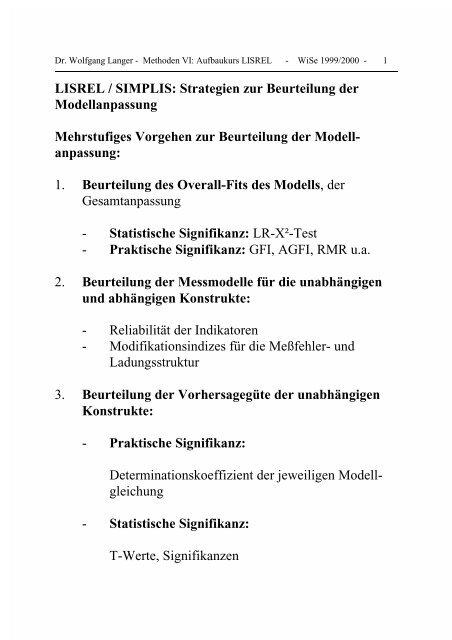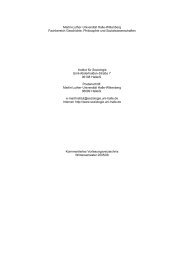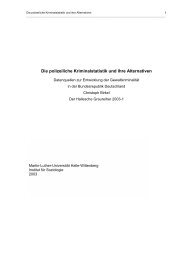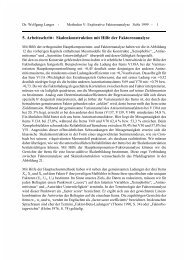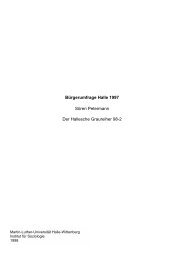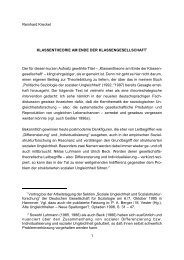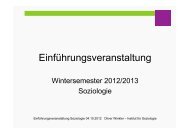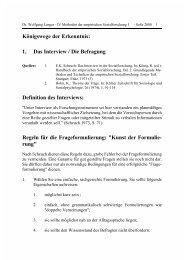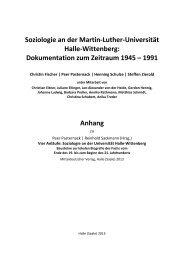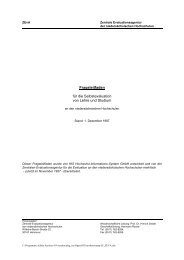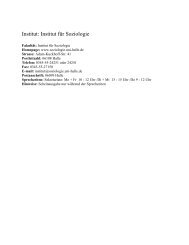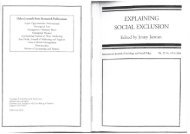LISREL / SIMPLIS: Strategien zur Beurteilung der Modellanpassung ...
LISREL / SIMPLIS: Strategien zur Beurteilung der Modellanpassung ...
LISREL / SIMPLIS: Strategien zur Beurteilung der Modellanpassung ...
Erfolgreiche ePaper selbst erstellen
Machen Sie aus Ihren PDF Publikationen ein blätterbares Flipbook mit unserer einzigartigen Google optimierten e-Paper Software.
Dr. Wolfgang Langer - Methoden VI: Aufbaukurs <strong>LISREL</strong> - WiSe 1999/2000 - 1<br />
<strong>LISREL</strong> / <strong>SIMPLIS</strong>: <strong>Strategien</strong> <strong>zur</strong> <strong>Beurteilung</strong> <strong>der</strong><br />
<strong>Modellanpassung</strong><br />
Mehrstufiges Vorgehen <strong>zur</strong> <strong>Beurteilung</strong> <strong>der</strong> <strong>Modellanpassung</strong>:<br />
1. <strong>Beurteilung</strong> des Overall-Fits des Modells, <strong>der</strong><br />
Gesamtanpassung<br />
- Statistische Signifikanz: LR-X²-Test<br />
- Praktische Signifikanz: GFI, AGFI, RMR u.a.<br />
2. <strong>Beurteilung</strong> <strong>der</strong> Messmodelle für die unabhängigen<br />
und abhängigen Konstrukte:<br />
- Reliabilität <strong>der</strong> Indikatoren<br />
- Modifikationsindizes für die Meßfehler- und<br />
Ladungsstruktur<br />
3. <strong>Beurteilung</strong> <strong>der</strong> Vorhersagegüte <strong>der</strong> unabhängigen<br />
Konstrukte:<br />
- Praktische Signifikanz:<br />
Determinationskoeffizient <strong>der</strong> jeweiligen Modellgleichung<br />
- Statistische Signifikanz:<br />
T-Werte, Signifikanzen
Dr. Wolfgang Langer - Methoden VI: Aufbaukurs <strong>LISREL</strong> - WiSe 1999/2000 - 2<br />
Alle drei Prüfungsschritte sind durchzuführen, da eine alleinige Favorisierung <strong>der</strong> Überprüfung<br />
<strong>der</strong> Gesamtmodellanpassung zu einer vorschnellen Falsifikation von Kausalmodellen führen<br />
kann, wie Sobel & Bohrnstedt (1984, S. 158) bereits bemerkt haben:<br />
"Scientific progress could be impeded if fit coefficients ... are used as the primary criterion for<br />
judging the adequacy of a model."<br />
Wheaton (1988, S. 199) schlägt daher vor, erstens die drei obigen Prüfungsschritte einzuhalten<br />
und zweitens mehrere Maßzahlen <strong>zur</strong> <strong>Beurteilung</strong> <strong>der</strong> <strong>Modellanpassung</strong> zu verwenden.<br />
1. Schritt: <strong>Beurteilung</strong> <strong>der</strong> Gesamtanpassung<br />
a) Statistische Signifikanz:<br />
Likelihood-Ratio-X²-Test: (Zentrale-X²-Verteilung)<br />
1. Fall: Annahme: Das spezifizierte Modell gilt exakt für die Grundgesamtheit !<br />
LR $² (n 1) F[S,(ˆ)]<br />
F: Minimum <strong>der</strong> Schätzfunktion<br />
S: Beobachtete Korrelations /Kovarianzmatrix<br />
: Unter Restriktionen geschätzte Korrelations<br />
/Kovarianzmatrix<br />
Mit folgen<strong>der</strong> Anzahl von Freiheitsgraden:<br />
D.F. s t<br />
Anzahl <strong>der</strong> nichtredundanten Elemente <strong>der</strong> Stichprobenmatrix S:<br />
k(k 1)<br />
s <br />
2<br />
t: Anzahl <strong>der</strong> unabhängig geschätzten Parameter<br />
k: Anzahl <strong>der</strong> Indikatoren<br />
Die Nullhypothese H 0 des LR-X²-Anpassungstests lautet: ("Badness of fit test")<br />
Die Abweichungen <strong>der</strong> Elemente <strong>der</strong> beobachteten und unter Restriktionen geschätzten<br />
Korrelations-/Kovarianzmatrix weichen statistisch nicht bedeutsam voneinan<strong>der</strong> ab.<br />
D.h., das spezifizierte Strukturmodell reproduziert die beobachtete Eingabematrix<br />
nahezu vollständig.
Dr. Wolfgang Langer - Methoden VI: Aufbaukurs <strong>LISREL</strong> - WiSe 1999/2000 - 3<br />
Die Alternativehypothese H A lautet:<br />
Die modellimmanent geschätzte Korrelations-/Kovarianzmatrix weicht statistisch<br />
bedeutsam von <strong>der</strong> beobachteten Stichprobenmatrix ab.<br />
Ziel <strong>der</strong> Analyse ist es, ein Modell zu finden, dessen Residuen nicht statistisch signifikant<br />
ausfallen. Da dieser Test sehr empfindlich auf den Stichprobenumfang reagiert -<br />
hohe Fallzahlen führen zu Falsifikation fast je<strong>der</strong> Modellstruktur (n 200), Modelle mit<br />
geringen Fallzahlen können faktisch nicht wi<strong>der</strong>legt werden (n 100) - entwickelten<br />
Jöreskog&Sörbom (1989) zwei Maßzahlen <strong>der</strong> praktischen Signifikanz <strong>zur</strong> <strong>Beurteilung</strong><br />
des Modellfits, die beide <strong>der</strong> allgemeinen Logik <strong>der</strong> Proportionalen Fehlerreduktion<br />
folgen, wie sie auch dem Determinationskoeffizienten R 2 zugrunde liegt.<br />
2. Fall: Modell gilt nur annäherungsweise für die Grundgesamtheit<br />
Für diesen Fall empfiehlt Browne (1984) die Verwendung <strong>der</strong> nichtzentralen X²-Verteilung<br />
mit dem Nichtzentralitätsparameter (lambda) und d-Freiheitsgraden. Dieser<br />
Lageparameter läßt sich anhand <strong>der</strong> Stichprobenverteilung folgen<strong>der</strong>maßen schätzen: 1<br />
Schätzung des Nichtzentralitätsparameters:<br />
ˆ Max[(Likelihood Ration $ 2 WLS D.F.),0]<br />
Mit Hilfe des mitgelieferten DOS-Utility-Programms “LISPOWER.EXE” können wir<br />
nun uns den kritischen Wert <strong>der</strong> nichtzentralen X²-Verteilung bei einer bestimmten<br />
Anzahl von Freiheitsgraden d, einem geschätzten Nichtzentralitätsparameter sowie<br />
einem vorgegebenen .-Niveau (Irrtumswahrscheinlichkeit) ermitteln lassen.<br />
Ab <strong>der</strong> Version 8.30 berechnet <strong>LISREL</strong> automatisch neben dem Nichtzentralitätsparameter<br />
den zugehörigen nichtzentralen X²-Anpassungstest für die mit Hilfe <strong>der</strong> WLS-<br />
Schätzung reproduzierte Korrelations-/ Kovarianzmatrix.<br />
1 S. Jöreskog & Sörbom 1993, S.117
Dr. Wolfgang Langer - Methoden VI: Aufbaukurs <strong>LISREL</strong> - WiSe 1999/2000 - 4<br />
b) Praktische Signifikanz: Klassische Maße für <strong>LISREL</strong> !<br />
Globale Anpassungsmaße:<br />
- Goodness of Fit-Index (GFI)<br />
- Adjusted Goodness of Fit Index (AGFI)<br />
- Root Mean squared Residuals (RMR)<br />
Die beiden ersten Indizes beruhen auf einer Normierung des LR-$²-Werts, wobei <strong>der</strong><br />
AGFI zusätzlich die Anzahl <strong>der</strong> Indikatoren und Freiheitsgrade berücksichtigt. Beim<br />
RMR handelt es sich um die Größe des geschätzten durchschnittlichen Residuums des<br />
Strukturgleichungsmodells. Je größer das durchschnittliche Residuum ausfällt, desto<br />
schlechter ist die <strong>Modellanpassung</strong>.<br />
Goodness of Fit Index (GFI) 1<br />
[0;1]<br />
F[S,( ˆ)<br />
F[S,(0)]<br />
Inhaltlich: Prozentsatz <strong>der</strong> Informationen von S,<br />
<strong>der</strong> durch das Kausalmodell reproduziert wird.<br />
S: Beobachtete Korrelations /Kovarianzmatrix<br />
: Modellimmanent reproduzierte Korrelations /Kovarianzmatrix<br />
Adjusted Goodness of Fit Index (AGFI)<br />
1<br />
( p q )(p q 1)<br />
2D.F.<br />
(1 GFI )<br />
[0;1]<br />
p: Anzahl <strong>der</strong> Y Indikatoren<br />
q: Anzahl <strong>der</strong> X Indikatoren<br />
D.F.: Anzahl <strong>der</strong> Freiheitsgrade
Dr. Wolfgang Langer - Methoden VI: Aufbaukurs <strong>LISREL</strong> - WiSe 1999/2000 - 5<br />
Root Mean Squared Residual (RMR)<br />
p q<br />
2 <br />
i 1<br />
i<br />
<br />
j 1<br />
(s ij<br />
1 ij<br />
) 2<br />
(pq) (pq1)<br />
p: Anzahl <strong>der</strong> Y Indikatoren<br />
q: Anzahl <strong>der</strong> X Indikatoren<br />
Faulbaum (1981, S. 22-44) schlägt für das GFI, AGFI sowie das RMR-Maß folgende Schwellenwerte<br />
für die <strong>Beurteilung</strong> <strong>der</strong> <strong>Modellanpassung</strong> an die empirische Stichprobe vor:<br />
Tab.1:<br />
<strong>LISREL</strong>/<strong>SIMPLIS</strong>: Kriterien für die <strong>Beurteilung</strong><br />
<strong>der</strong> <strong>Modellanpassung</strong> (Daumenregeln)<br />
Quelle: Faulbaum, F.: Konfirmatorische Analysen <strong>der</strong> Reliabilität von Wichtigkeitseinstufungen<br />
beruflicher Merkmale. ZUMA-Nachrichten, 9 (1981), S.22-44<br />
Modellfit: GFI: AGFI: RMR:<br />
vollständig bestätigt<br />
0.98 0.95 0.05<br />
tendentiell bestätigt<br />
0.95 GFI < 0.98 0.90 AGFI < 0.95 0.05 RMR < 0.10<br />
insgesamt abgelehnt<br />
< 0.95 < 0.90 > 0.10<br />
Für den Likelihood-Ratio-$²-Test gilt, wenn die Irrtumswahrscheinlichkeit p 0.10 ausfällt,<br />
d.h., niedriger als 10 % ist, gilt die spezifizierte Modellstruktur für die vorliegende<br />
Stichprobe als falsifiziert (wi<strong>der</strong>legt).
Dr. Wolfgang Langer - Methoden VI: Aufbaukurs <strong>LISREL</strong> - WiSe 1999/2000 - 6<br />
An<strong>der</strong>e LR-X²-basierte globale Anpassungsmaße<br />
1. Akaike-Information-Criterium<br />
Akaike Information Criterium:<br />
AIC c D.F.<br />
c: L.R.$ 2 <strong>der</strong> aktuellen Modells<br />
D.F.: Anzahl unabhängig geschätzten Parameter<br />
Interpretation des AIC-Maßes:<br />
Beim Vorliegen mehrerer alternativer Modelle wähle dasjenige aus, dessen AIC-Wert am<br />
niedrigsten ist.<br />
2. Bozdogans Corrected-Akaike-Information-Criterium<br />
Die von Bozdogan vorgeschlagene Korrektur des Akaike-Information-Kriteriums berücksichtigt<br />
zusätzlich <strong>zur</strong> Parameteranzahl den Stichprobenumfang. Für das CAIC gilt dieselbe Anwendungsregel<br />
wie für das AIC.<br />
Bozdogans Corrected Information Criterium:<br />
CAIC c (1 ln n)D.F.<br />
n : Stichprobenumfang
Dr. Wolfgang Langer - Methoden VI: Aufbaukurs <strong>LISREL</strong> - WiSe 1999/2000 - 7<br />
3. Browne & Cudeck: Single-sample-cross-validation index (ECVI)<br />
Browne und Cudeck (1993) haben einen Index vorgeschlagen, <strong>der</strong> auf <strong>der</strong> Idee <strong>der</strong> “Kreuzvalidierung”<br />
anhand gesplitteter Substichproben beruht. Es mißt das Ausmaß <strong>der</strong> Übereinstimmung<br />
zwischen <strong>der</strong> modellimmanent geschätzten Kovarianzmatrix <strong>der</strong> Analysestichprobe und <strong>der</strong>jenigen,<br />
die beim identischen Stichprobenumfang aus <strong>der</strong> Validierungsstichprobe reproduziert wird.<br />
Bei <strong>der</strong> von Jöreskog & Sörbom implementierten Variante handelt es sich lediglich um eine<br />
Transformation des LR-X²-Werts.<br />
Browne&Cudeck Single Sample Cross Validation Index:<br />
ECVI L.R.$2 M A<br />
n<br />
2<br />
D.F. M A<br />
n<br />
4. Hoelter: Critical N (CN)-Maß<br />
Hoeltern schlug eine Umkehrung <strong>der</strong> Logik des LR-X² Tests in dem Sinne vor, daß er sich<br />
fragte, ab welchem Stichprobenumfang beim vorliegenden Wert des LR-X²-Tests die Nullhypothese<br />
<strong>der</strong> vollständigen Reproduktion <strong>der</strong> Stichprobenkovarianzmatrix <strong>zur</strong>ückgewiesen werden<br />
muß. Für die <strong>Beurteilung</strong> des Modells stellt er folgende „Daumenregeln“ auf:<br />
“Hoelter suggests, with some care, a threshold level of 200 (times the number of groups in a<br />
multisample analysis) for this measure. This means that a model has an acceptable fit should<br />
have a CN of at least 200 (per sample).” (Wheaton 1988, S. 203)<br />
Hoelter Critical N:<br />
CN L.R.$2 1 .<br />
F(S,(ˆ))<br />
Das von Hoelter vorgeschlagene „Criticial-N“-Maß eignet sich m.E. am ehesten dazu, abzuschätzen,<br />
ob bei <strong>der</strong> bekannten Sensitivität des LR-$ 2 -Test für große Stichprobenumfänge das<br />
betrachtete Strukturmodell überhaupt eine Chance hat, nicht falsifiziert zu werden. Liegt das<br />
Kritische N bei einem vorgegebenen Signifikanzniveau von 5 o<strong>der</strong> 10 % deutlich niedriger als<br />
<strong>der</strong> aktuelle Stichprobenumfang, so ist Wi<strong>der</strong>legung <strong>der</strong> Nullhypothese unvermeidlich. Daher<br />
eignet sich das von Hoelter vorgeschlagenen Fitmaß eher zu Abschätzung <strong>der</strong> Stärke des LR-$ 2<br />
-Tests als <strong>zur</strong> <strong>Beurteilung</strong> <strong>der</strong> <strong>Modellanpassung</strong>. (S. Bollen&Liang 1988)
Dr. Wolfgang Langer - Methoden VI: Aufbaukurs <strong>LISREL</strong> - WiSe 1999/2000 - 8<br />
Maße <strong>der</strong> partiellen / relativen <strong>Modellanpassung</strong><br />
Alle Maße partiellen <strong>Modellanpassung</strong> beruhen auf <strong>der</strong>selben Grundidee. Hierbei vergleichen<br />
sie den Fit / die Anpassung des aktuellen Modells (M A ) mit <strong>der</strong>jenigen eines zuvor gewählten<br />
und geschätzten Vergleichsmodells. Bei diesem Modell handelt es sich jeweils um ein restriktiver<br />
spezifiziertes Modell (M R ), das über weniger Schätzer verfügt. Als “absoluter Vergleichsmaßstab”<br />
dient ein sogenanntes Nullmodell (M 0 ), das von <strong>der</strong> statistischen Unabhängigkeit <strong>der</strong><br />
beobachteten Indikatoren ausgeht. Dieses “Nullmodell” schätzt lediglich die Varianzen <strong>der</strong><br />
beobachteten Indikatoren. Alle Kovarianzen werden auf Null restringiert o<strong>der</strong> gesetzt.<br />
Die von einer Reihe von Autoren vorgeschlagenen partiellen Anpassungsmaße sind in <strong>LISREL</strong><br />
8 .30 implementiert und verfügen über die folgenden gemeinsamen Definitionsbestandteile:<br />
F A<br />
: Minimum <strong>der</strong> Fit Funktion des aktuellen Modells (M A<br />
)<br />
F 0<br />
: Minimum <strong>der</strong> Fit Funktion des Nullmodells (M 0<br />
)<br />
d A<br />
: Anzahl <strong>der</strong> Freiheitsgrade von M A<br />
d 0<br />
: Anzahl <strong>der</strong> Freiheitsgrade von M 0<br />
f A<br />
nF A<br />
d A<br />
L.R.$ M A<br />
2<br />
d A<br />
f 0<br />
nF 0<br />
d 0<br />
L.R.$ M 0<br />
2<br />
d 0<br />
2 A<br />
Max(nF A<br />
d A<br />
,0):Nichtzentralitätsparamter M A<br />
2 0<br />
Max(nF 0<br />
d 0<br />
,0):Nichtzentralitätsparamter M 0<br />
Eines <strong>der</strong> ersten Incremental Fit-Maße haben Bentler&Bennett (1980) entwickelt. Ihr Ziel<br />
bestand darin, entsprechend <strong>der</strong> Logik <strong>der</strong> Proportionalen Fehlerreduktion ein Fitmaß zu<br />
entwickeln, das auf den Wertebereich von Null bis Eins normiert ist und sich analog zum<br />
Determinationskoeffizienten R 2 interpretieren läßt. Sie schlugen den Normed-Fit-Index sowie<br />
den Non-Normed-Fit-Index vor.
Dr. Wolfgang Langer - Methoden VI: Aufbaukurs <strong>LISREL</strong> - WiSe 1999/2000 - 9<br />
1. Bentler&Bonetts (1980) Normed Fit Index (NFI):<br />
Bentler&Bonnett Normed FIT Index 1980:<br />
Bollens û 1<br />
Index 1989:<br />
NFI 1 F A<br />
F 0<br />
1 L.R.$2 M A<br />
L.R.$ 2 M 0<br />
[0;1]<br />
2. Bentler&Bonetts (1980) Non Normed Fit Index (NNFI):<br />
Bentler&Bonetts Non Normed Fit Index (NNFI) 1980:<br />
Tucker Lewis Index (TLI) 1973:<br />
Bollen !2 (rho2) 1989:<br />
L.R.$ 2 M 0<br />
L.R.$ 2 M A<br />
NNFI f 0 f A<br />
f 0<br />
1 d M0<br />
d MA<br />
L.R.$ 2 M 0<br />
1<br />
d M0<br />
Für die Interpretation ihrer NFI und NNFI-Indizes geben Bentler&Benett (1980) folgende<br />
„Daumenregel“ an:<br />
„Since the scale of the fit indices is not necessarily easy to interpret (e.g., the indices are not<br />
squared multiple correlations), experience will be required to establish values of the indices<br />
that are associated with various degrees of meaningfulness of results. In our experience, models<br />
with overall fit indices of less than .9 can usually be improved substantially. These indices, and<br />
the general hierarchical comparision described previously, are best un<strong>der</strong>stood by examples.“<br />
(Dies. 1980, S. 600)<br />
Mit Hilfe ihrer Simualtionsstudien haben Marsh, Balla&Hau (1996) eine Vielzahl von Fit-<br />
Indizes im Hinblick auf ihr Eignung für die praktische Datenanalyse überprüft. Hierbei haben<br />
sie nachgewiesen, daß die Größe des NFI vom Stichprobenprobenumfang direkt abhängig ist.<br />
Hingegen empfehlen sie als partielles Anpassungmaß den von Tucker&Lewis (1973) entwickel-
Dr. Wolfgang Langer - Methoden VI: Aufbaukurs <strong>LISREL</strong> - WiSe 1999/2000 - 10<br />
ten Index, welchen Bentler&Bonnett (1980) später als Non-Normed-Fit-Index bezeichneten.<br />
Bollen (1989) führte für ihn in seinem <strong>LISREL</strong>-Buch die Bezeichnung !2 ein. Ihres Erachtens<br />
verfügt <strong>der</strong> NNFI o<strong>der</strong> TLI über folgende Vorteile, die seine beson<strong>der</strong>e Eignung für die <strong>Beurteilung</strong><br />
<strong>der</strong> <strong>Modellanpassung</strong> rechtfertigen:<br />
1. Er ist unabhängig von <strong>der</strong> Stichprobengröße.<br />
2. Er berücksichtigt adäquat die Modellkomplexität als Manus.<br />
3. Er erfaßt systematisch Unterschiede <strong>der</strong> Fehlspezifikation des Modells.<br />
4. Ausreißer mit Indexwerten über 1.0 treten in <strong>der</strong> praktischen Datenanalyse sehr selten<br />
auf.<br />
Um diese Ausreißer zu eliminieren, empfehlen Marsh, Balla & Hau (1996, S.331) daher die<br />
folgende Normierung für den Tucker-Lewis-Index (TLI):<br />
Normierungsvorschrift für den Tucker Lewis Index (TLI o<strong>der</strong> NNFI)<br />
<strong>zur</strong> Berechnung des Normed Tucker Lewis Index (NTLI):<br />
1. Fall NNFI 1o<strong>der</strong> NCP A<br />
0 ist (auch D.F. A<br />
0,<br />
sowie NCP A<br />
und NCP 0<br />
0), dann setze NTLI1.0;<br />
3. Ansonsten gilt: NTLI NNFI<br />
Berechnung <strong>der</strong> Nichtzentralitätsparameter <strong>der</strong> Population(NCP):<br />
Nullmodell: NCP 0<br />
(L.R.$2 M 0<br />
D.F. M0<br />
)<br />
n<br />
Alternativmodell: NCP A<br />
(L.R.$2 M A<br />
D.F. MA<br />
)<br />
n<br />
„Except for this possible limitation that was not evident in our research and may not be typical<br />
in practice, the NNFI was the most successful index consi<strong>der</strong>ed here in relation to the criteria<br />
typically used to evaluate incremental fit indices. For these reasons we recommand the routine<br />
use of the NNFI (or, perhaps, its normed counterpart, the NTLI).“ (Dies 1996, S. 347)
Dr. Wolfgang Langer - Methoden VI: Aufbaukurs <strong>LISREL</strong> - WiSe 1999/2000 - 11<br />
Für unser Pfadmodell (LPFADAB2.SPL) läßt sich <strong>der</strong> von Bentler&Bonnett (1980) vorgeschlagene<br />
NFI sowie <strong>der</strong> Tucker-Lewis-Index (NNFI) folgen<strong>der</strong>maßen anhand <strong>der</strong> von <strong>LISREL</strong><br />
bereitgestellten Angaben zum Null- und Alternativmodell berechnen:<br />
Anpassungstest: LR $ 2 D.F.<br />
Alternativmodell(M A<br />
): 303,11 57<br />
Nullmodell(M 0<br />
): 3810,24 78<br />
Berechnung des Bentler&Benett NFI:<br />
NFI 1 L.R.$2 M A<br />
L.R.$ 2 M 0<br />
1 303,11<br />
3810,24<br />
1 0,0796 0,92<br />
Berechnung des Tucker Lewis Index(TLI o<strong>der</strong> NNFI):<br />
TLI o<strong>der</strong> NNFI <br />
L.R.$ 2 M 0<br />
d M0<br />
L.R.$ 2 M A<br />
d MA<br />
L.R.$ 2 M 0<br />
d M0<br />
1<br />
<br />
3810,24<br />
78<br />
3810,24<br />
78<br />
303,11<br />
57<br />
1<br />
0,9098 o<strong>der</strong> 0,91<br />
Da 0,91 0,90 ist, gilt die Modellstruktur als bestätigt!
Dr. Wolfgang Langer - Methoden VI: Aufbaukurs <strong>LISREL</strong> - WiSe 1999/2000 - 12<br />
3. James, Mulaik & Brett (1982) Parsimony Normed Fit Index:<br />
Die Grundidee <strong>der</strong> von James, Mulaik & Brett vorgeschlagenen „Sparsamkeitskorrektur“<br />
bestehen<strong>der</strong> Anpassungsmaße besteht darin, diese am Quotienten <strong>der</strong> Freiheitsgrade des aktuellen<br />
und des Nullmodells zu normieren. Diese Form <strong>der</strong> Standardisierung honoriert eine möglichst<br />
sparsame Spezifikation <strong>der</strong> Meß- und Strukturkomponenten. „Daumenregeln“ <strong>zur</strong><br />
<strong>Beurteilung</strong> <strong>der</strong> praktischen <strong>Modellanpassung</strong> haben die Autoren aber nicht entwickelt.<br />
James, Mulaik &Brett Parsimony Normed Fit Index:<br />
PNFI d A<br />
d 0<br />
1 F A<br />
F 0<br />
4. Mulaik et.al. (1989) Parsimony-Goodness-of-Fit-Index:<br />
Mulaik s Parsimony Goodness of Fit Index (PGFI):<br />
PGFI <br />
2d A<br />
k(k 1) GFI<br />
k: Anzahl <strong>der</strong> beobachteten Indikatoren<br />
GFI: Jöreskog&Sörboms Goodness of Fit Index
Dr. Wolfgang Langer - Methoden VI: Aufbaukurs <strong>LISREL</strong> - WiSe 1999/2000 - 13<br />
5. Bentler’s (1990) Comparative-Fit-Index (CFI):<br />
Gestützt auf ihre Simulationsstudien empfehlen Marsh, Balla & Hau (1996) den von Bentler<br />
entwickelten Comparative-Fit-Index (CFI) <strong>zur</strong> <strong>Beurteilung</strong> <strong>der</strong> globalen <strong>Modellanpassung</strong>. Er<br />
ist identisch mit dem von McDonald&Marsh (1990) vorgeschlagenen Relative-Noncentrality-<br />
Index (RNI), <strong>der</strong> sich mit Hilfe <strong>der</strong> Likelihood-Ratio-$ 2 -Werte des aktuellen und des Nullmodells<br />
berechnen läßt.<br />
Bentler s Comparative Fit Index (CFI) 1990:<br />
CFI 1 2 A<br />
2 0<br />
1 NCP M A<br />
NCP M0<br />
[0;1]<br />
McDonald&Marsh Relative Noncentrality Index (RNI) 1990:<br />
RNI 1 L.R.$2 M A<br />
D.F. MA<br />
L.R.$ 2 M 0<br />
D.F. M0<br />
Berechnung des CFI / RNI für das Pfadmodell:(LPFADAB2.SPL)<br />
RNI 1 L.R.$2 M A<br />
D.F. MA<br />
1<br />
L.R.$ 2 M 0<br />
D.F. M0<br />
303,11 57<br />
3810,24 78<br />
0,9341 o<strong>der</strong> 0,93<br />
Im Hinblick auf den RNI-Index fassen Marsh, Balla & Hau die Ergebisse ihrer Simulationsstudie<br />
folgen<strong>der</strong>maßen zusammen:<br />
„RNI. In the present comparison, the RNI was not systematically related to sample size, had<br />
mean values of approximately 1.0 for true approximating models and appropriately reflected<br />
systematic variation in model misspecification. In this respect, it was successful in relation to<br />
its intended goals. The only substantial limitation for this index, perhaps, is its failure to<br />
penalize appropriately for model complexity (i.e., RNIs were larger for overfit models with<br />
superfluous parameter estimates) and to reward model parsimony (i.e., RNIs were smaller for<br />
the parsimonious models that imposed equality constraints known to be true in the population).<br />
... Because the RNI was well behaved in relation to its intended goals and most of the desirable<br />
criteria proposed here, we recommend the continued use of the RNI (or, perhaps, its normed<br />
counterpart, the CFI).“ (Dies 1996, S. 346)
Dr. Wolfgang Langer - Methoden VI: Aufbaukurs <strong>LISREL</strong> - WiSe 1999/2000 - 14<br />
Arbuckle (1997, S. 555f.) stellt folgende „Daumenregel“ für den Comparative-Fit-Index auf:<br />
Modelle mit einem CFI nahe Eins verfügen über eine sehr gute Anpassung.<br />
Für die praktische Datenanalyse empfehlen Marsh, Balla & Hau die Verwendung von Fit-<br />
Indizes unterschiedlichster Konstruktionsprinzipien. Ihres Erachtens haben sich am besten die<br />
Kombination aus Relative-Noncentrality-Index und Non-Normed-Fit-Index bzw. Comparative-<br />
Fit-Index und Normed-Tucker-Lewis-Index bewährt.<br />
„The RNI and NNFI were both well behaved in the present comparison in that values of these<br />
indices were relatively unrelated to sample size. However, these two indices behaved differently<br />
in relation to the introduction of superfluous parameters and of equality constraints. RNI has<br />
no penalty for model complexity or reward for model parsimony, whereas NNFI penalizes<br />
complexity and rewards parsimony. In this respect, the two indices reflect qualitatively different,<br />
apparently complimentary characteristics. Based on these results, we recommend that<br />
researchers wanting to use incremental fit indices should consi<strong>der</strong> both RNI (or perhaps its<br />
normed counterpart, CFI and NNFI (or perhaps its normed counterpart, NTLI). The juxtaposition<br />
between the two should be particularly useful in the evaluation of a series of nested or<br />
partially nested modells. The RNI provides an index of the change in fit due to the introduction<br />
of new parameters or constraints on the model, but will typically lead to the selection of the<br />
least parsimonious model within a nested sequence. Here the researcher must use a degree of<br />
subjectivity in determining whether the change in fit is justified in relation to the change in<br />
parsimony. The NNFI embodies a control for model complexity and a reward for parsimony<br />
such that the optimal NNFI may be achieved for a model of intermediate complexity.“ (Dies<br />
1996, S. 351)
Dr. Wolfgang Langer - Methoden VI: Aufbaukurs <strong>LISREL</strong> - WiSe 1999/2000 - 15<br />
6. Bollen’s (1986) Relative-Fit-Index (RFI):<br />
Bollen s Relative Fit Index (RFI) 1986:<br />
L.R.$ 2 M A<br />
RFI o<strong>der</strong> !1 f 0 f A<br />
f 0<br />
1<br />
D.F. MA<br />
L.R.$ 2 M 0<br />
D.F. M0<br />
Berechnung des RFI für das Pfadmodell (LPFADAB2.SPL):<br />
RFI o<strong>der</strong> !1 1<br />
303,11<br />
57<br />
3810,24<br />
78<br />
0,8911 o<strong>der</strong> 0,89<br />
Marsh, Balla & Hau (1996) zeigen, daß <strong>der</strong> Relative-Fit-Index von Bollen im Gegensatz zum<br />
Normed- Fit-Index von Bentler & Bonnett (1980) zwar die Modellkomplexität adäquat berücksichtig,<br />
er aber mit dem Stichprobenumfang systematisch kovariiert.<br />
„NFI and RFI. The NFI was proposed by Bentler and Bennett (1980) to provide an incremental<br />
fit index that varied on a 0 to 1 scale. Although heuristic, subsequent research showed that<br />
NFI was biased by N, a conclusion consisting with the results of this study. The RFI was<br />
developed, in part, in response to this problem with the NFI, but subsequent research and the<br />
present results show that it is also substantially biased by sample size. Hence, neither the NFI<br />
nor the RFI are recommended for routine use.“ (Dies. 1996, S. 345)
Dr. Wolfgang Langer - Methoden VI: Aufbaukurs <strong>LISREL</strong> - WiSe 1999/2000 - 16<br />
7. Bollen’s (1989) Incremental-Fit-Index (IFI):<br />
Bollen s Incremental Fit o<strong>der</strong> û 2<br />
Index (IFI):<br />
IFI o<strong>der</strong> û 2<br />
nF 0 nF A<br />
L.R.$2 M 0<br />
L.R.$ 2 M A<br />
nF 0<br />
D.F. A L.R.$ 2 M 0<br />
D.F. MA<br />
Berechnung des û 2<br />
o<strong>der</strong> IFI für das Pfadmodell (LPFADAB2.SPL):<br />
IFI o<strong>der</strong> û 2<br />
<br />
3810,24 303,11<br />
3810,24 57<br />
0,9344 o<strong>der</strong> 0,93<br />
Nach Bollens (1989) eignen Angaben ist <strong>der</strong> Incremental-Fit-Index nicht zwingen<strong>der</strong> maßen auf<br />
den Wertebereich zwischen Null und Eins begrenzt. Er berücksichtigt zwar ausdrücklich den<br />
Stichprobenumfang und die Modellkomplexität, aber Marsh, Balla & Hau (1996) haben gezeigt,<br />
daß <strong>der</strong> IFI erstens mit dem Stichprobenumfang kovariiert und zweitens seine Verzerrung nur<br />
bei „wahren Modellen“ Null ist. Daher wi<strong>der</strong>sprechen sie vehement <strong>der</strong> Empfehlung von<br />
Gerbing & An<strong>der</strong>son (1993, S. 63) und raten von <strong>der</strong> Verwendung des IFI in <strong>der</strong> Datenanalysepraxis<br />
eindringlich ab.<br />
„In the present analysis, a more detailed evaluation of the mathematical properities of IFI and<br />
the Monte Carlo results both indicate that: (a) IFI is positively biased for misspecified models<br />
and that the size of this bias is more positive for small N; (b) the adjustment for df is inappropriate<br />
in that it penalizes model parsimony and rewards model complexity; and (c) the<br />
inappropriate penalty for model parsimony and reward for model complexity is larger for small<br />
N. ... These undesirable properties of IFI summarized here demonstrate that this index has not<br />
achieved its intended goals or claims by its proponents. For these reasons the IFI is not recommended<br />
for routine use.“ (Dies. 1996, S. 346)
Dr. Wolfgang Langer - Methoden VI: Aufbaukurs <strong>LISREL</strong> - WiSe 1999/2000 - 17<br />
8. Population Error of Approximation<br />
Der klassische Likelihood-Ratio-$ 2 -Anpassungstest beruht auf <strong>der</strong> Annahme, daß das spezifizierte<br />
Modell exakt in <strong>der</strong> Grundgesamtheit, auch Population genannt, gilt. Als Konsequenz hier<br />
aus werden Modelle, die nur approximativ in <strong>der</strong> Population gelten, in großen Stichproben stets<br />
falsifiziert. Browne und Cudeck (1993) schlugen eine Reihe von Maßzahlen vor, die sich<br />
speziell dem Approximationsfehler und <strong>der</strong> Messgenauigkeit des Anpassungsmaßes widmen.<br />
Sie definieren ihren Schätzer <strong>der</strong> Population Discrepancy Function (PDF) folgen<strong>der</strong>maßen, den<br />
Steiger (1990) für seinen Root Mean Square Error of Approximation (RMSEA) benötigt:<br />
Browne&Cudecks Population discrepancy function(PDF):<br />
ˆF 0<br />
Max<br />
ˆF D.F. M A<br />
n 1 , 0 Max L.R.$ 2 M A<br />
D.F. MA<br />
, 0 NCP<br />
n 1<br />
n 1<br />
Steigers Root Mean Square Error of Approximation (RMSEA)1990:<br />
RMSEA <br />
ˆF 0<br />
D.F. MA<br />
Da <strong>der</strong> Wert <strong>der</strong> Populationsdiskrepanzfunktion im allgemeinen abnimmt , wenn man zusätzliche<br />
Parameter im Strukturgleichungsmodell schätzen läßt, zugleich aber die Komplexität des<br />
Modells zunimmt, schlugen Browne & Cudeck (1993) vor, den von Steiger (1990) entwickelten<br />
RMSEA-Koeffizienten als Maß <strong>der</strong> durchschnittlichen Diskrepanz pro Freiheitsgrad zu betrachten.<br />
Browne & Cudeck (1993) haben die folgenden „Daumenregeln“ für die Interpretation des<br />
RMSEA-Koeffizienten aufgestellt:<br />
„Practical experience has made us feel that a value of the RMSEA of about .05 or less would<br />
indicate a close fit of the model in relation to the degrees of freedom. This figure is based on<br />
sujective judgment. It cannot be regarded as infallible or correct, but it is more reasonable than<br />
the requirement of exact fit with the RMSEA=0.0. We are also of the opinion that a value of<br />
about 0.08 or less for the RMSEA would indicate a reasonable error of approximation and<br />
would not want to employ a model with a RMSEA greater than 0,1.“ (Dies. 1993, S. 144)
Dr. Wolfgang Langer - Methoden VI: Aufbaukurs <strong>LISREL</strong> - WiSe 1999/2000 - 18<br />
Tab.2:<br />
Daumenregeln für die Interpretation des RMSEA - Maßes<br />
(Browne&Cudeck 1993)<br />
RMSEA-Maß:<br />
RMSEA 0,05<br />
<strong>Beurteilung</strong> des Modellfits:<br />
Guter Fit: Modell bestätigt.<br />
0,05 < RMSEA 0,08 Mäßiger Fit: Modell tendenziell bestätigt.<br />
RMSEA > 0,10<br />
Schlechter Fit: Modell wi<strong>der</strong>legt.<br />
Hayduk (1996) bezieht ausdrücklich Stellung gegen die sich abzeichnende Flut neuer Anpassungmaße:<br />
„Researchers interested in structural equation modeling as a tool, and not as a vocation, are<br />
advised to awoid detailed pursuit of the plethora of new fit indices for the next few years. For<br />
most purposes it is sufficient to report the $ 2 test (and its probability) as long as this is complemented<br />
by a discussion of model parsimony as evidenced in the $ 2 degrees of freedom, a<br />
discussion of the degree of test sensitivity provided by the sample size, a report of the adjusted<br />
goodness of fit index (AGFI) and a discussion of any noticeable patternings in the residuals.<br />
Having fully reported and discussed $ 2 and having mentioned the AGFI index, one should turn<br />
one‘s attention to more detailed indices of particular components of the model fit, or to alternative<br />
models, or to equivalent models, or to consi<strong>der</strong>ations of the styles of data that might<br />
substantively distinguish between models, or whatever it is that is of import in the relevant<br />
literature.“ (Ders. 1996, S. 201)
Dr. Wolfgang Langer - Methoden VI: Aufbaukurs <strong>LISREL</strong> - WiSe 1999/2000 - 19<br />
Diskussionsebenen für den Vergleich von Goodness/Badness-of-Fit<br />
Maßen für Strukturgleichungsmodelle: (Tanaka 1993, S. 16)
Dr. Wolfgang Langer - Methoden VI: Aufbaukurs <strong>LISREL</strong> - WiSe 1999/2000 - 20<br />
Vergleich gängiger Anpassungsmaße auf den vorgegebenen Dimensionen:<br />
(Tanaka 1993, S. 32)
Dr. Wolfgang Langer - Methoden VI: Aufbaukurs <strong>LISREL</strong> - WiSe 1999/2000 - 21<br />
Diskussionsstand <strong>der</strong> Anpassungsmaße für Strukturgleichungsmodelle:<br />
Literatur:<br />
1. Bollen, Kenneth A. & Long, J. Scott (eds):<br />
Testing structural equation models.<br />
Newbury Park, Ca: SAGE, 1993<br />
2. Tanaka, J. S.(1993):<br />
Multifaceted conceptions of fit in structural equation models.<br />
In: Bollen&Long (1993), S. 10-39<br />
3. Gerbing, David W. & An<strong>der</strong>sonen, James C.(1993):<br />
Monte Carlo evaluations of goodness-of-fit-indices.<br />
In: Bollen&Long (1993), S. 40-65<br />
4. Browne, Michael W. & Cudeck, Robert (1993):<br />
Alternative ways of assessing model fit.<br />
In: Bollen&Long (1993), S.136-162<br />
5. Jöreskog, Karl G.(1993):<br />
Testing structural equation models.<br />
In: Bollen&Long (1993), S.294-315<br />
6. Mulaik, Stanley A., James, Larry R., Alstine, Judith Van, Bennett, Nathan, Lind, Sherri<br />
& Stilwell, C. Dean:<br />
Evaluation of goodness-of-fit indices for structural equation models.<br />
In: Psychological Bulletin, 105 (1989), 3, S. 430 - 445<br />
7. Jöreskog, Karl G. & Sörbom, Dag (1993):<br />
<strong>LISREL</strong> 8: Structural equation modeling with the <strong>SIMPLIS</strong> command language.<br />
Hillsdale, N.J.: Lawrence Erlbaum<br />
8. Wheaton, Blair (1988):<br />
Assessment of fit in overidentified models with latent variables.<br />
In: Long, J. Scott (ed.): Common problems / proper solutions.<br />
Newbury Park, Ca.: SAGE, 1988, S. 193 - 225<br />
9. Marsh, H..W., Balla, J.R. & Hau, K-F. (1996):<br />
An Evaluation of Incremental Fit Indices: A clarification of mathematical and empirical<br />
properties.<br />
In: Marcoulides, G.A. & Schumacker, R.E. (Eds.):<br />
Advanced Structural Equation Modeling. Issues and Techniques.<br />
Mahwah, N.J.: Erlbaum, 1996, S. 315-353
Dr. Wolfgang Langer - Methoden VI: Aufbaukurs <strong>LISREL</strong> - WiSe 1999/2000 - 22<br />
10. Bollen, K.A. & Liang, J. (1988):<br />
Some Properties of Hoelter’s CN.<br />
In: Sociological Methods & Research, 16 (4), S. 492 - 503<br />
11. Arbuckle, J. (1997):<br />
Amos User’s Guide Version 3.6.<br />
Chicago, Ill.: Small Waters Corporation u. SPSS Inc.


